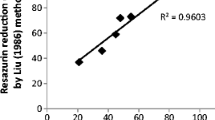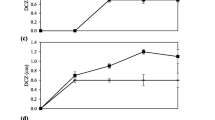Abstract
One of the most important factors that affect the operation efficiency of sequencing batch reactor (SBR) technology is bacterial viability and biomass activity. The acute toxicity of three heavy metals to four dominant strains of sequencing batch reactor (Pseudomonas, Aeromonas, Enterobacter, and Bacillus) was investigated using a resazurin bioassay. After exposing the bacterial strains to soluble compound of Hg, Cd, and Pb, at more than five selected concentrations, the median effective concentration (EC50) and the mortality rate values were calculated. Large differences were observed in sensitivities of the four bacterial strains to the metals. Pseudomonas showed the highest sensitivity for Cd (EC50 = 0.06 μmol/L) and Hg (EC50 = 11.75 μmol/L), while Aeromonas showed the highest sensitivity for Pb (EC50 = 48.27 μmol/L). Considering the EC50 test results, it was concluded that Pseudomonas and Aeromonas are excellent and reliable bioindicators for assessing the toxicity of water and wastewaters polluted by Cd, Hg, and Pb. The rapidity (30 min) and simplicity of the resazurin bioassay procedure enable this enzymatic test to be used in toxicity assessment of small and decentralized wastewater treatment plants (WWTPs).

Similar content being viewed by others

References
Abou-Shanab, A. I., van Berkum, P., & Angle, J. S. (2007). Heavy metal resistance and genotypic analysis of metal resistance genes in gram-positive and gram-negative bacteria present in Ni-rich serpentine soil and in the rhizosphere of Alyssum murale. Chemosphere, 68, 360–367.
Albergoni, V., Piccinni, E. (1983). Biological response to trace metals and their biochemical effects. In: Leppard, G.G. (Ed.), Trace element speciation in surface waters and its ecological implications. Plenum, New York, pp. 159–174.
Brock, T. D., Madigan, M. T., Martinko, J. M., & Parker, J. (1994). Biology of microorganisms (7th ed., pp. 169–191). Englewood Cliffs: Prentice-Hall.
Chaperon, S., & Sauve, S. (2007). Toxicity interaction of metals (Ag, Cu, Hg, Zn) to urease and dehydrogenase activities in soils. Soil Biology and Biochemistry, 39, 2329–2338.
Congeevaram, S., Dhanarani, J., Park, M., Dexilin, K., & Thamaraiselvi, K. (2007). Biosorption of chromium and nickel by heavy metal resistant fungal and bacterial isolates. Journal of Hazardous Material, 146, 270–277.
Diaz-Ravina, M., Baath, E., & Frostegard, A. (1994). Multiple heavy metal tolerance of soil bacterial communities and its measurement by a thymidine incorporation technique. Applied Environmental Microbiology, 60, 2238–2247.
Fulladosa, E., Murat, J. C., & Villaescusa, I. (2005). Study on the toxicity of binary equitoxic mixtures of metals using the luminescent bacteria Vibrio fischeri as a biological target. Chemosphere, 58, 551–557.
Gellert, G. (2000). Sensitivity and significance of luminescent bacteria in chronic toxicity testing based on growth and bioluminescence. Ecotoxicology and Environmental Safety, 45, 87–91.
Gellert, G., & Stommel, A. (1999). Influence of microplate material on the sensitivity of growth inhibition tests with bacteria assessing toxic organic substances in water and waste water. Environmental Toxicology, 14, 424–428.
Glenner, G. G. (1961). Tetrazolium salts. In H. J. Conn (Ed.), Biological stains (pp. 230–235). Baltimore: The Williams & Wilkins Company.
Hassen, A., Saidi, N., Cherif, M., & Boudabous, A. (1998). Resistance of environmental bacteria to heavy metals. Bioresource Technology, 64, 7–15.
Hsieh, C. Y., Tsai, M. H., Ryan, D. K., & Pancorbo, O. C. (2004). Toxicity of the 13 priority pollutant metals to Vibrio fisheri in the Microtox chronic toxicity test. Science of the Total Environment, 320, 37–50.
Irato, P., & Piccinni, E. (1996). Effects of cadmium and copper on Astasia longa: metal uptake and glutathione levels. Acta Protozoologica, 35, 281–285.
Jose, J., Giridhar, R., Anas, A., Bharathi, P. A. L., & Nair, S. (2011). Heavy metal pollution exerts reduction/adaptation in the diversity and enzyme expression profile of heterotrophic bacteria in Cochin estuary, India. Environmental Pollution, 159(10), 2775–2780.
Kahru, A., Ivask, A., Kasemets, K., Po-Llumaa, L., Kurvet, I., Franc-Ois, M., & Dubourguier, H. C. (2005). Biotests and biosensors in ecotoxicological risk assessment of field soils polluted with zinc, lead, and cadmium. Environmental Toxicology and Chemistry, 24(11), 2973–2982.
Kelly, C. J., Lajoie, C. A., Layton, A. C., & Sayler, G. S. (1999). Bioluminescence reporter bacterium for toxicity monitoring in biological wastewater treatment systems. Water Environment Research, 71, 31–35.
Kim, S. J. (1985). Effect of heavy metals on natural populations of bacteria from surface microlayers and subsurface water. Marine Ecology Progress Series, 26, 203–206.
Kim, S. U., Cheong, Y. H., Seo, D. C., Hur, J. S., Heo, J. S., & Cho, J. S. (2007). Characterisation of heavy metal tolerance and biosorption capacity of bacterium strain CPB4 (Bacillus spp.). Water Science and Technology, 55, 105–111.
Li, J., Xing, X. H., & Wang, B. Z. (2003). Characteristics of phosphorus removal from wastewater by biofilm sequencing batch reactor (SBR). Biochemical Engineering Journal, 16, 279–285.
Liu, D. (1981). A rapid biochemical test for measuring chemical toxicity. Bulletin of Environmental Contamination and Toxicology, 26, 145–149.
Ord, M.J., Al-Atia, G.R. (1979). The intracellular effects of cadmium: an experimental study using Amoeba proteus as a single cell model. In: Webb, M. (Ed.), The chemistry, biochemistry and biology of cadmium. Elsevier/North-Holland Biomedical, pp. 141–173.
Ow, D. (1993). Phytochelatin-mediated cadmium tolerance in Schizosaccharomyces pombe. In Vitro Cellular & Developmental Biology, 29, 213–219.
Ren, S. (2003). Frymier, P.D. Kinetics of the toxicity of metals to luminescent bacteria. Advances in Environmental Research, 7, 537–547.
Sillanpaa, M., & Oikari, A. (1996). Assessing the impact of complexation by EDTA and DTPA on heavy metal toxicity using Microtox bioassay. Chemosphere, 32(8), 1485–1497.
Sobolev, D., & Begonia, M. F. T. (2008). Effects of heavy metal contamination upon soil microbes: lead-induced changes in general and denitrifying microbial communities as evidenced by molecular markers. International Journal of Environmental Research and Public Health, 5, 450–456.
Sprocati, A. R., Alisi, C., Segre, L., Tasso, F., Galletti, M., & Cremisini, C. (2006). Investigating heavy metal resistance, bioaccumulation and metabolic profile of a metallophile microbial consortium native to an abandoned mine. Science of the Total Environment, 366, 649–658.
Sreenivasan, P. K., Tambs, G., Gittins, E., Nabi, N., & Gaffar, A. (2003). A rapid procedure to ascertain the antimicrobial efficacy of oral care formulations. Oral Microbiology and Immunology, 18, 371–378.
Sterritt, R. M., & Lester, J. N. (1980). Interactions of heavy metals with bacteria. Science of the Total Environment, 14, 5–17.
Tomioka, N., Uchiyama, H., & Yagi, O. (1994). Cesium accumulation and growth characteristics of Rhodococcus erythropolis CS98 and Rhodococcus sp. strain CS40Z. Applied and Environmental Microbiology, 60, 2227–2231.
Tsiridis, V., Petala, M., Samaras, P., Hadjispyrou, S., Sakellaropoulos, G., & Kungolos, A. (2006). Interactive toxic effects of heavy metals and humic acids on Vibrio fischeri. Ecotoxicology and Environmental Safety, 63, 158–167.
Venkata Mohan, S., Chandrashekara Rao, N., Krishna Prasad, K., Madhavi, B. T. V., & Sharma, P. N. (2005). Treatment of complex chemical wastewater in a sequencing batch reactor (SBR) with an aerobic suspended growth configuration. Process Biochemistry, 40(5), 1501–1508.
Venkata, M. S., & Sharma, P. N. (2002). Pharmaceutical wastewater and treatment technologies. Pharma Bio World, 11(1), 93–100.
Wang, F., Yao, J., Si, Y., Chen, H., Russel, M., Chen, K., Qian, Y., Zaray, G., & Bramanti, E. (2010). Short-time effect of heavy metals upon microbial community activity. Journal of Hazardous Material, 173, 510–516.
Acknowledgments
This study has been performed with financial support from the Environment Research Center, Isfahan University of Medical Sciences, Isfahan, Iran, Project No. 2282, and the Department of Environmental Health Engineering, School of Health, Isfahan University of Medical Sciences, Isfahan, Iran. This study was conducted by the first author as part of the requirement to attain a Ph.D. degree, Isfahan University of Medical Sciences, Isfahan, Iran.
Conflict of interest
The authors declare that they have no conflict of interest.
Author information
Authors and Affiliations
Corresponding author
Rights and permissions
About this article
Cite this article
Zare, MR., Amin, MM., Nikaeen, M. et al. Acute toxicity of Hg, Cd, and Pb towards dominant bacterial strains of sequencing batch reactor (SBR). Environ Monit Assess 187, 263 (2015). https://doi.org/10.1007/s10661-015-4457-y
Received:
Accepted:
Published:
DOI: https://doi.org/10.1007/s10661-015-4457-y



